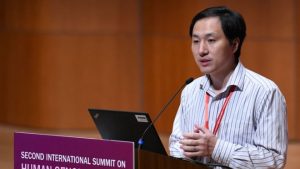” Maailman ensimmäiset geenimuokatut lapset syntyivät
Monet tutkijat kutsuvat kokeilua vastuuttomaksi.
Kiinasta kuultiin maanantaina uutinen, joka jää tieteen historiaan. Hyvässä tai pahassa.
Tutkija Jiankui He ilmoitti luoneensa maailman ensimmäiset geeni- muokatut ihmislapset. He kertoi uutistoimisto AP:lle muokanneensa kahden ihmisalkion geenejä niin, että tuloksena syntyi kaksi tervettä tyttölasta, joista toinen on immuuni hi-virukselle.
Tuntemattomassa paikassa pari viikkoa sitten syntyneet kaksosty- töt ”Lulu” ja ”Nana” ovat ensimmäiset ihmiset, joiden geenejä on peruuttamattomasti muunneltu alkiovaiheessa.
Koe perustuu geenisaksiksi kutsuttuun crispr-cas9-menetelmään, joka on mullistanut biotekniikan. Siinä soluun ruiskutetaan dna:ta leikkaava proteiini ja pätkä rna:ta, joka ohjaa leikkurin oikeaan paikkaan. Näin voidaan muuttaa yksittäisten geenien toimintaa hyvinkin tarkasti.
Geenimuokkaus tehtiin osana tavallista koeputkihedelmöitystä. Lasten äidin munasolu hedelmöitettiin maljassa isän siittiöllä. Sitten soluun ruiskutettiin cas9-entsyymi yhdessä crispr-molekyylien kanssa. Ne poistivat kehittyvien alkioiden perimästä geenin, jota hi-virus tarvitsee tarttuakseen elimistöön.
”Kun Lulu ja Nana olivat vasta yksi solu, tämä leikkaus poisti oven, jonka kautta hi-virus tarttuu. Ennen kuin istutimme solut äidin kohtuun, avasimme koko geeniperimän ja näimme, että leikkaus onnistui kuten piti”, He selittää videolla, jolla hän kertoo kokeestaan.
”Syntymän jälkeen avasimme jälleen Lulun ja Nanan koko geeniperi- män. Varmistui, ettei mikään muu geeni muuttunut kuin se, joka estää hiv-tartunnan. Vauvat ovat yhtä terveitä ja turvassa kuin muutkin lapset”, He vakuuttaa.
Kiinassa on jo aiemmin tehty saman kaltaisia kokeita ihmisalkioilla, mutta alkioita ei ole siirretty kohtuun.
Geenimuokatun ihmislapsen luomista on pidetty teknisesti mahdolli- sena, mutta äärimmäisen tuomittavana, sillä riskejä ei tarkasti tiedetä.
He on ilmeisesti tehnyt kokeensa luvatta ja salassa. Kiina suhtautuu tutkimusetiikkaan löyhästi, mutta Shenzenin yliopisto, jossa He toimii apulaisprofessorina, irtisanoutui kokeesta ja ilmoitti olevansa ”järkyttynyt”.
Myös suuri joukko kiinalaisia tutkijoita tuomitsi ihmisalkion geenien muuntelun. Yli sata tutkijaa on uutistoimisto Reutersin mukaan allekirjoittanut avoimen kirjeen, jossa koetta luonnehditaan perustelemattomaksi, vaaralliseksi ja vahingolliseksi kiinalaiselle tutkijayhteisölle.
”Kansainvälisen transgeeniteknologiayhdistyksen kautta on paikan päältä Kiinasta tullut tieto, että ihmisessä ilmeisesti on tosiaan tehty ensimmäinen crispr-korjaus ja lapset ovat syntyneet”, vahvistaa crispr-tekniikkaa hiirillä hyödyntävä dosentti Satu Kuure Helsingin yliopistosta.
Tiedeyhteisö ei ole vielä voinut perehtyä Hen kokeeseen tarkemmin. Hän julkisti kokeensa suoraan medialle juuri ennen kuin geenieditointia ja sen riskejä pohtiva alan konferenssi käynnistyi Hongkongissa.
Tässä vaiheessa kokeesta tiedetään vain se, mitä He on haastatteluissa ja julkaisemallaan Youtube-videolla kertonut. Lisäksi AP:n haastattele- mat ulkopuoliset tutkijat ovat ilmeisesti saaneet nähdä jonkinlaista alustavaa dataa.
He värväsi kokeeseen seitsemän kiinalaista pariskuntaa, joille tehtiin hedelmöityshoitoja. Pariskunnat saivat Hen mukaan päättää, ottavatko he tavallisen koeputkihedelmöityksen vai haluavatko he kokeilla geenimuunneltua alkiota.
Kaikilla isillä oli hiv. He perusteli koetta vanhemmille sillä, että he voivat saada lapsia, jotka ovat ikuisesti suojassa hiviltä.
Lopulta 16:n alkion geenejä muokattiin. Muokkauksen kohteena oli hyvin tunnettu ccr5-geeni, josta ihminen perii yhden kopion isältä ja toisen äidiltä. Molempien geenien vaimentaminen tekee ihmisestä lähes immuunin hiv:lle.
Toisen tytön kohdalla geenistä onnistuttiin ilmeisesti vaimentamaan molemmat kopiot. Toisella hiljentyi vain toinen kopio, joten tämä tyttö voi yhä saada tartunnan.
Ilmeisesti kävi myös niin, että geenimuuntelu onnistui vain osassa tämän tytön soluista. Geeni on siis vaiennettu osassa soluista ja osassa se toimii yhä.
”Tämä on arpapeliä. Tällä hetkellä lapset ovat ilmeisesti terveitä, mutta tulevaisuudesta ei tiedetä”, Kuure kommentoi.
On olemassa ihmisiä, joilta luonnostaan puuttuu toinen tai kumpikin ccr5-geeni. Tällainen mutaatio liittyy luultavasti Euroopassa riehuneisiin isorokkoepidemioihin.
Kaksosiin tehty muutos ei siis periaatteessa eroa piirteestä, jonka osa ihmisistä saa luonnollisesti. Tällaista geeniteknistä parannusta ei kuitenkaan ole koskaan aiemmin tehty ihmiseen. Länsimaissa vasta tutkitaan tekniikan turvallisuutta eläimillä ja aikuisilla.
On esimerkiksi mahdollista, että geenieditointi voi aiheuttaa syövän myöhemmin.
”Hiirillä on nähty, että syöpään liittyvät geenit voivat aktivoitua ja kor-jausmekanismit menevät sekaisin. Hiirellä tämä näyttää korjautuvan, mutta emme tiedä, mitä ihmiselle tapahtuu. Hiiri elää niin paljon lyhyemmän ajan, että syövän kehittymistä ei ehkä ehditä nähdä”, Kuure selittää.
Hänen mielestään tekniikkaa pitäisi ensin tutkia huolellisesti ja edetä varovaisesti.
Kokeessa alkioilta ei parannettu mitään vakavaa perinnöllistä sairaut- ta, johon he olisivat ilman hoitoa sairastuneet. Tytöt olisivat syntyneet normaaleina ja terveinä ilman hiviä joka tapauksessa. He saattavat nyt olla immuuneja hiville, mutta samalla on otettu riski vakavista sivuvaikutuksista. ”
https://www.bbc.com/news/world-asia-china-46382662#


Kaikki on mahdollista, mutta erheet kostautuvat.
Jos olisimme kaikki samoilla geeneillä varustettuja niin joku virus saattaisi tappaa jne.
Entinen Itävällan natsi nobelisti Konrad Lorenzkin tuli vanhemmiten siihen tulokseen, että ”rodunjalostus on aina rodunhuononnusta”…
https://www.scientificamerican.com/article/potential-dna-damage-from-crispr-seriously-underestimated-study-finds/
STAT Medical & Biotech
Potential DNA Damage from CRISPR “Seriously Underestimated,” Study Finds
A flurry of recent findings highlight a contentious question in this area
By Sharon Begley, STAT on July 16, 2018
From the earliest days of the CRISPR-Cas9 era, scientists have known that the first step in how it edits genomes—snipping DNA—creates an unholy mess: Cellular repairmen frantically try to fix the cuts by throwing random chunks of DNA into the breach and deleting other random bits. Research published on Monday suggests that’s only the tip of a Titanic-sized iceberg: CRISPR-Cas9 can cause significantly greater genetic havoc than experts thought, the study concludes, perhaps enough to threaten the health of patients who would one day receive CRISPR-based therapy.
The results come hard on the heels of two studies that identified a related issue: Some CRISPR’d cells might be missing a key anti-cancer mechanism and therefore be able to initiate tumors.
The DNA damage found in the new study included deletions of thousands of DNA bases, including at spots far from the edit. Some of the deletions can silence genes that should be active and activate genes that should be silent, including cancer-causing genes.
Leading CRISPR companies scrambled to play down the latest threat to what they hope will be a multibillion-dollar business—and to their stock prices, but investors reacted with alarm. Within the first 20 minutes of when the study was released, the three publicly traded CRISPR companies lost more than $300 million in value.
The companies questioned whether the CRISPR-caused DNA damage reported in the new study applied to the kind of cells they’re planning to CRISPR. They emphasized that if genomic scrambling is at all common then it should also be seen in earlier forms of genome-editing such as zinc fingers and TALENs (but apparently isn’t). And they insisted they’re on the case.
“We’re not Pollyannaish about this,” said geneticist Tom Barnes, chief innovation officer at Intellia Therapeutics. For its mouse experiments, Intellia analyzes edited genomes for collateral damage both near the editing target and tens of thousands of DNA letters away, he said, but “we have not seen any [cancer-causing] transformation of these cells, even with all the edits we’ve introduced.”
In a statement, Editas Medicine spokeswoman Cristi Barnett said the possibility of genetic chaos from CRISPR is “an interesting topic” that the company “actively examine[s].” The reported DNA havoc, she said, is not “specifically problematic in our work to make CRISPR-based medicines.” CRISPR Therapeutics did not respond to requests for comment.
Academic scientists were less dismissive of the new study, in Nature Biotechnology. One leading CRISPR developer called it “well-done and credible,” “a cautionary note to the [genome-editing] community,” and consistent with other research showing that the DNA cuts that CRISPR makes, called double-stranded breaks, “can induce the types of genomic DNA rearrangements and deletions they report.” He asked not to be identified so as not to jeopardize business relationships with genome-editing companies.
But just as critics of last month’s studies asked why, if CRISPR’d cells can initiate cancer, no CRISPR’d mice had turned up with tumors, so scientists raised similar questions about the new genomic havoc finding: Why don’t scientists see it when they analyze the DNA of CRISPR’d cells?
“You find what you look for,” said Bradley. “No one is looking at the impact [of these DNA changes] on downstream genes.”
And few studies conduct full-out genome sequencing of CRISPR’d cells. Moreover, scientists typically search for one form of the collateral damage the Sanger study found—deletions of thousands of DNA bases (the double helix’s famous A’s, T’s, C’s, and G’s)—using a standard technique called PCR, which makes millions of DNA copies. But to work, PCR must attach to a “binding site” on DNA; CRISPR sometimes deletes that binding site, said Bradley, whose team used a different technique to analyze the double helix for collateral damage from CRISPR.
The Sanger scientists didn’t set out to find collateral DNA damage from CRISPR. As they investigated how CRISPR might change gene expression, a “weird thing” showed up, Bradley said: The target DNA was accurately changed, but that set off a chain reaction that engulfed genes far from the target. The scientists therefore changed course.
When they aimed CRISPR at different targets in mouse embryonic stem cells, mouse blood-making cells, and human retinal cells, “extensive on-target genomic damage [was] a common outcome,” they wrote in their paper. In one case, genomes in about two-thirds of the CRISPR’d cells showed the expected small-scale inadvertent havoc, but 21 percent had DNA deletions of more than 250 bases and up to 6,000 bases long.
Since therapeutic uses of CRISPR would edit the genomes of billions of cells in, say, a patient’s liver, even rare DNA damage “makes it likely that one or more edited cells… would be endowed with an important [disease-causing] lesion,” the scientists wrote.
Nature Biotechnology took a year to publish the paper, after asking Bradley numerous variations of “are you sure?” and “did you consider this?” and asking him to run additional experiments, Bradley said. The results all held up.
The one U.S. clinical trial using CRISPR’d cells began recruiting patients this year. It will use CRISPR to make immune cells, removed from patients with any of four types of cancer, attack telltale molecules on the tumor cells’ surface. Asked what genome analysis he plans to do, lead investigator Dr. Edward Stadtmauer of the University of Pennsylvania said, “We are doing extensive testing of the final cellular product as well as the cells within the patient.”
The possibility of adverse consequences from CRISPR’d cells has caused some company officials to argue that if, say, their therapy cures a child of a devastating disease, but increases her risk of cancer, that might be an acceptable trade-off.
That argument may well prevail. In 2003, however, when a boy in a gene therapy trial in France developed leukemia because the repair gene landed in the wrong place in his genome and activated a cancer-causing gene, it shut down gene therapy development on both sides of the Atlantic for years.
Republished with permission from STAT. This article originally appeared on July 16, 2018
ABOUT THE AUTHOR(S)
Sharon Begley
Recent Articles
With Brain Implants, Scientists Aim to Translate Thoughts into Speech
CRISPR Cures Inherited Disorder in Mice
Study Cracks Open the Secrets of Genetic Mutations That Boost Breast and Ovarian Cancer Risk